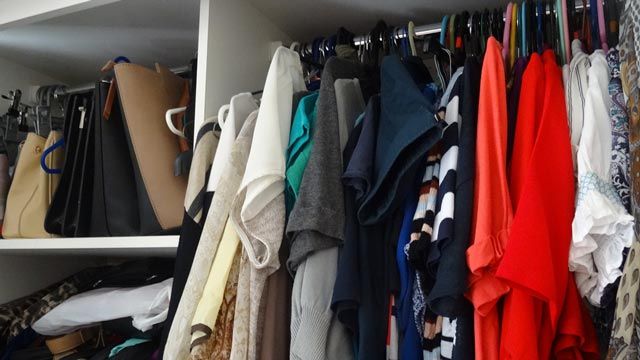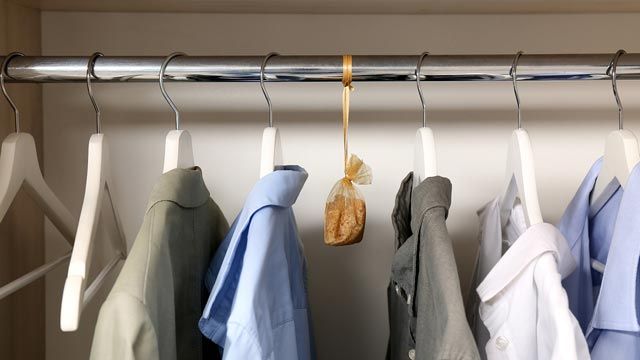Table of contents
Have you noticed that your closets smell bad? Have you spotted black specks on your favorite garments? This is mold and clearly indicates that your closet has generated humidity, i.e., that fungi have proliferated .
And, precisely, humidity is one of the most frequent problems when it comes to cleaning and organizing the house. On the one hand, there are houses that tend to humidity for structural reasons and, on the other hand, there are others in which humidity is a problem. lack of cleanliness and ventilation cause the appearance of dampness and pests such as silverfish or dampness insects.
In this article we focus on the best natural solutions to remove moisture from closets, dressers and other furniture.
7 tricks to eliminate moisture in the closet
Take note of these simple solutions to prevent and eliminate humidity in any closet (built-in or not) at home:
1. Ventilate constantly
Did you know that air is the great enemy of humidity? It is very important that your home breathes, that is, that you ventilate your home daily, not only to avoid humidity, but also to improve the quality of the air in your home.
And, to do so, all you have to do is open those troubled and damp cabinets and leave them open for 30 to 60 minutes a day Make sure that during this time, the window or door of the room is also open, as this favors the circulation and renewal of air.
2. Avoid cluttering the closet
It seems logical, but how many of us cram and pile clothes and other belongings into our clothes closets? In fact, I'm sure that when you open your closet, you have a hard time finding the clothes you were looking for.
The easiest thing to do will undoubtedly be, store clothes according to the capacity of the closet And, depending on what you use! For example, one of the premises of Marie Kondo's Konmari method is that you only keep those clothes that make you happy and that you are going to wear. And no, you can't use the excuse that you will use it as "pajamas".
The ideal, according to the Japanese guru, is to to have everything in sight Hang only the clothes that need to hang, such as shirts, jackets or silk dresses. Keeping everything handy makes it easier to wear them more often.

A cluttered closet causes clutter and can exacerbate the moisture problem.
3. Eliminates mold
If the problem is serious and you find mildew stains on your clothes, take action! If the garments are cotton and colored, the most effective solution is to soak them in hot water with equal parts white vinegar or ammonia diluted in water (ratio: 1/10). Let the mildewed garments stand for 40 to 60 minutes and then wash them as usual.
If the clothes are white, the best solution is to wash them with bleach, either by hand or in the washing machine.
On the other hand, if you find a fungal surface , rub it with a little hydrogen peroxide for 10 minutes. After this time, remove the hydrogen peroxide with a cloth dampened with water and wait until the cabinet is completely dry.
Check the walls as well. If they show yellowish stains or black specks, you should brush them with a solution of equal parts bleach and water (bleach or chlorine bleach) until all the mold is removed from the wall.
4. Resorts to coffee
The properties and uses of coffee and coffee grounds (leftovers) are ideal for to eliminate dampness and unpleasant odor left by mildew in clothes closets .
All you have to do is to place the coffee beans (ground or leftover) in breathable cloth bags and place them in the cupboards in question. It is important that the cloth has "little holes" so that the coffee can have its magical effect.

Another of the 11 fantastic uses of coffee grounds is that it is ideal to repel insects and to eliminate the smell of tobacco in a room.
5. Use baking soda.
On numerous occasions we have talked about the different uses and properties of baking soda, one of the most powerful and effective cleaners and whiteners on the market.
In the case of cabinets and drawers, you only need to place the sodium bicarbonate in sachets or cloth bags and place them in drawers and corners where moisture thrives.
If you do not have sodium bicarbonate, you can resort to sachets with 15-20 grams of rice In this last solution, keep in mind that you must change the bags every 10 days, otherwise they could serve as food for white worms or moth larvae, a typical kitchen pest.
6. Use chalk
Another magical solution to moisture in the cabinets comes from the hand of chalk. The chalk, which is used to write on the blackboard, has properties that absorb moisture from the room where they are located.
To do so, all you have to do is place 4 or 5 chalks in fine cloth bags with holes in them Not only will you eliminate the odor from the affected clothes and closet, but you will also prevent the moisture from continuing to spread to other surfaces such as walls or your clothes.

Keep in mind that you must change the chalk sachet every three months so that the new chalks can absorb moisture.
7. Use charcoal
You may have heard that the charcoal is perfect for eliminating humidity in closets and corners that tends to proliferate fungus. It's true!
To do this, just wrap or roll the charcoal in kitchen paper and place it in drawers and moldy corners - it's an almost magical solution!
Finally, we advise you to check that your clothes are completely dry before putting them away. If they are still damp, let them dry and iron them, especially in the winter months, when it is almost obligatory to hang clothes indoors.

